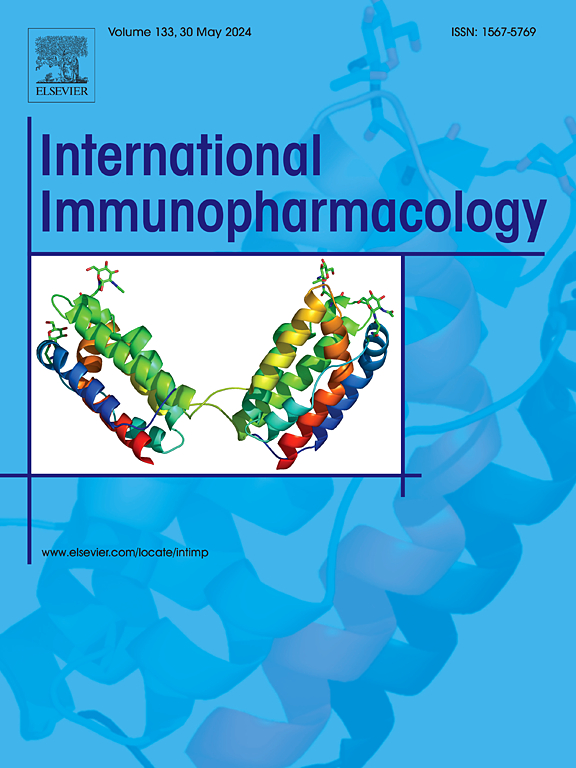Laminaran增强cGAS-STING信号以增强抗病毒反应。
IF 4.8
2区 医学
Q2 IMMUNOLOGY
引用次数: 0
摘要
环GMP-AMP合成酶(cGAS)-干扰素基因刺激因子(STING)信号通路是先天抗病毒免疫应答的重要组成部分,已成为先天免疫系统通过识别外源性和内源性DNA来调节I型ifn产生和应答的关键组成部分。虽然已经开发了一些cGAS-STING信号传导小分子激动剂,但很少有报道称天然多糖可以激活cGAS-STING信号传导以治疗感染性疾病。在这里,我们报道了褐藻中存在的一种低分子量β-葡聚糖储存多糖Laminaran,它可以增强cGAS-STING信号,促进I型ifn的产生和抗病毒反应。Laminaran增强了cGAS-STING信号介导的I型ifn的产生和对HSV-1感染或DNA模拟刺激的反应。重要的是,我们发现Laminaran明显抑制单纯疱疹病毒1 (HSV-1)诱导的C57BL/6J小鼠的死亡和炎症反应,并增加I型ifn的诱导。在机制上,我们发现Laminaran抑制自噬,抑制STING自噬降解,积极调节cGAS-STING信号反应。综上所述,我们揭示了Laminaran通过增强cGAS-STING信号反应在DNA触发先天免疫中的作用。Laminaran可能是一种潜在的治疗病毒性传染病的候选药物。本文章由计算机程序翻译,如有差异,请以英文原文为准。
Laminaran potentiates cGAS-STING signaling to enhance antiviral responses
Cyclic GMP–AMP synthase (cGAS)-Stimulator of interferon genes (STING) signaling pathway, an essential element in the innate antiviral immune responses, has emerged as a key component of innate immune system to modulate type I IFNs production and response by recognizing both exogenous and endogenous DNA. Although some cGAS-STING signaling small molecule agonists have been developed, there are few natural polysaccharides reported to activate cGAS-STING signaling for the treatment of infectious diseases. Here, we reported that Laminaran, a low molecular weight β-glucan storage polysaccharide present in brown algae, potentiates cGAS-STING signaling to promote type I IFNs production and antiviral response. Laminaran enhanced cGAS-STING signaling mediated type I IFNs production and response both in human and murine cells upon HSV-1 infection or DNA mimics stimulation. Importantly, we found that Laminaran markedly inhibited Herpes simplex virus-1 (HSV-1) induced death and inflammatory responses and increased the induction of type I IFNs in C57BL/6J mice. Mechanistically, we found Laminaran inhibited autophagy and suppressed STING autophagic degradation to positively regulate cGAS-STING signaling response. Taken together, we uncovered the function of Laminaran in DNA triggered innate immunity by enhancing cGAS-STING signaling response. Laminaran might be a potential therapeutic candidate for viral infectious diseases.
求助全文
通过发布文献求助,成功后即可免费获取论文全文。
去求助
来源期刊
CiteScore
8.40
自引率
3.60%
发文量
935
审稿时长
53 days
期刊介绍:
International Immunopharmacology is the primary vehicle for the publication of original research papers pertinent to the overlapping areas of immunology, pharmacology, cytokine biology, immunotherapy, immunopathology and immunotoxicology. Review articles that encompass these subjects are also welcome.
The subject material appropriate for submission includes:
• Clinical studies employing immunotherapy of any type including the use of: bacterial and chemical agents; thymic hormones, interferon, lymphokines, etc., in transplantation and diseases such as cancer, immunodeficiency, chronic infection and allergic, inflammatory or autoimmune disorders.
• Studies on the mechanisms of action of these agents for specific parameters of immune competence as well as the overall clinical state.
• Pre-clinical animal studies and in vitro studies on mechanisms of action with immunopotentiators, immunomodulators, immunoadjuvants and other pharmacological agents active on cells participating in immune or allergic responses.
• Pharmacological compounds, microbial products and toxicological agents that affect the lymphoid system, and their mechanisms of action.
• Agents that activate genes or modify transcription and translation within the immune response.
• Substances activated, generated, or released through immunologic or related pathways that are pharmacologically active.
• Production, function and regulation of cytokines and their receptors.
• Classical pharmacological studies on the effects of chemokines and bioactive factors released during immunological reactions.

 求助内容:
求助内容: 应助结果提醒方式:
应助结果提醒方式:


